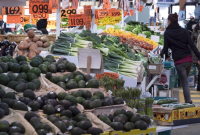Support strong Canadian climate journalism for 2025
Canada’s Food Guide has been overhauled, and it’s good news for anyone who cares about public health, the environment or animals.
The new food guide is simplified, offering straightforward guidelines suggesting proportions rather than portions. At the same time, it’s broad in scope, allowing for cultural and personal variation in eating patterns.
Plant-based proteins and fats are emphasized, because high consumption of plant-based foods is associated with lowered risk of heart disease, cancers, diabetes, and obesity. Instead of limiting fats, we’re advised to choose unsaturated fats. And there’s no more dairy food group: water is suggested as the beverage of choice, while dairy products lower in saturated fat can optionally—but not necessarily—be included as protein foods.
The new food guide highlights that our food choices are heavily influenced by external factors, including food marketing and our food environment. To that end, the new food guide prominently encourages Canadians to read food labels and to be aware that food marketing can influence our choices. Publicly funded institutions such as hospitals and schools are also advised to make available only foods that align with Canada’s dietary guidelines.
These guidelines pave the way for policy reforms that make good food choices the easy food choices. In the Blue Zones—regions of the world where people live unusually long and healthy lives—it’s not that people are exceptionally disciplined when it comes to diet and exercise. Plant-rich diets and regular movement are simply part of the culture, along with a strong focus on social connection, which the food guide also endorses in its encouragement to eat with others.
The food guide is better for the planet
Similarly, Canadian policy-makers and institutional leaders now are expected to create food environments that support health. One day we’ll wonder how vending machines were ever permitted in schools or why hospitals served health-compromising bacon and jello.
There are many potential policies across government departments that could complement the food guide: federal funding for plant-based protein innovation; fair food regulations that ensure a level playing field for plant-based products; transparent labels that indicate the health, environmental, and animal welfare impacts of food; systems of taxes and subsidies that steer people away from unhealthy foods and towards healthy ones, and clear acknowledgment in our federal sustainability strategy of the importance of eating more plant foods and fewer animal foods.
Although the food guide is about health, not environment, it so happens that the recommendations in the food guide are better for the planet, too. Animal farming is a leading contributor to climate change, water pollution (think of the fertilizers, pesticides, and herbicides added to feed crops as well as manure runoff), land and fresh water usage, biodiversity loss, and ocean degradation. Besides problems of overfishing and fish farming, nearly half of plastic ocean pollution is discarded fishing nets.
Research shows that environmental footprints are generally proportional to the magnitude of animal-based food restriction: the more animal foods we eat, the bigger our environmental footprint. In fact, shifting Western diets to plant-based eating patterns could could reduce greenhouse gas emissions by an incredible 70 per cent and land use by 80 per cent. This makes intuitive sense because it takes far more resources to grow feed crops for animals—who need to be housed and kept alive for weeks or months—than it does to grow plants to eat directly. Protein-rich legumes in particular are drought tolerant, sequester carbon from the atmosphere, and improve soil health, thanks to their unique ability to add nitrogen to soil.
A nightmare for animals
Our modern food system has also been a nightmare for the animals trapped within it. We genetically manipulate animals to have profitable traits—like laying 340 eggs per year or growing grotesquely rapidly—that inherently compromise their welfare. We separate mothers from babies at birth, or sometimes before. We confine animals in barren, filthy, air-polluted indoor environments that don’t meet their emotional, social, or physical needs. And as soon as it makes commercial sense, we kill them on fast-moving slaughter lines where horrifying mistakes are all too common.
There are many problems in the world that seem unsolvable or not to have clear solutions. Our food system doesn’t have to be one of them. Diets rich in plants foods are better for us, better for the planet, and better for the animals. May we make the modest changes in our lives and communities that will lead us towards a healthier, greener, kinder future.
Editor's note: This article was updated at 11:15 a.m. ET on Jan. 24, 2019 to correct a typographical error in a sentence that should have said that it takes more resources to grow feed crops for animals than it does to grow plants to eat directly.






Comments
While I agree with most of this opinion piece that the new food guide is much better, I have two serious disagreements. First is the inconvenient truth that plants are NOT vegetarian: vegetable and grain production must receive inputs from livestock. The alternative is to substitute synthetic fertilizers which is the major use of fossil fuels in mainstream agriculture (it takes 10 calories of fossil fuels to produce 1 calorie of food). Second, because economics and government policy have pushed livestock into confined environments, we have conflated all animal protein with that model of production. Well managed cattle (like on my farm) enable an ecosystem which is actually an overall carbon sink. In other words the way you manage cattle can turn a huge source of GHGs into a system that removes more GHGs from the environment than it contributes. See https://www.youtube.com/watch?v=vpTHi7O66pI
Finally, pulses are not that drought tolerant; ask my neighbour who left every one of their pulse crops to rot in the field because of the Ontario spring drought whereas perennial pasture for cattle fared far better. Do follow the new food guide; when it comes to meat eat less but better.